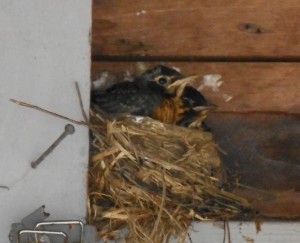Lea Wait's Blog, page 265
March 22, 2016
My Father’s Grin
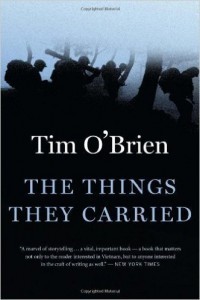 Every writer I knows who has a dedicated working space has furnished it. This piece came out of a challenge prompt from Tim O’Brien’s writing. What do you carry on your daily sojourns?
Every writer I knows who has a dedicated working space has furnished it. This piece came out of a challenge prompt from Tim O’Brien’s writing. What do you carry on your daily sojourns?
My Father’s Grin
Like all people who love their work, I seek to establish an integrity in it, to make what I love to do and what I have to do one and the same. And like all superstitious beings, I need amulets to add magic to what conscious effort and thought can make possible. The largest of these charms is the writing desk I carried home from Oregon, built from red madrona wood. It is the field for the other things that carry me to work:
My father’s grin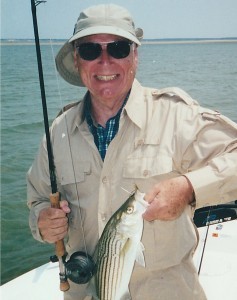
On the back left corner of my desk sits a photo of my father. He stands in a small boat off Cape Cod, holding up a very small fish he’s caught on a fly rod, his first ever. He’s 72 years old and the grin under his sun hat is as goofy and beatific as a boy on his first bike. This photograph reminds me there is no more blessed attitude than that of the amateur, the person who works for love. It tells me to take on things for no other reason than love, the love of something new, the chance to try something you don’t already know how to do. My father’s grin reminds me that while mastery is potent, a wide and seeking love is more so. He reminds me that each task has intrinsic value, and to accept the grace in that.
My mother’s quilt
On the wall in front of my desk hangs a red and white flying-goose pattern quilt my mother sewed for my wife and me. A daughter of the Depression, she still finds it difficult to believe in the abundance of this world, though all her generosities – unspoken and (by her preference) unattributed, bely that part of her history. The quilt and quilter sit with me every day to remind me that, even when I feel I have no more resources, when I feel most poor, I can always afford to give something away through my work. And that will make me better.
My grandfather’s knife
In the right-hand drawer of the madrona desk sits my grandfather’s pocket knife with the black bone handle and deer-horn ends. I forever see him using it to dig out the compacted roots of shrubs he’s transplanting, to cut the fleshy stems of roses for grafts, or to lop a length of string to tie a bunch of newspapers. I use it in the ways he used it, and for sharpening pencils and peeling apples beside, and to remember that, with patience and effort, the most difficult work breaks down into single, simple tasks. Often it’s the simple tools we require, despite what we think, or wish.
Some rocks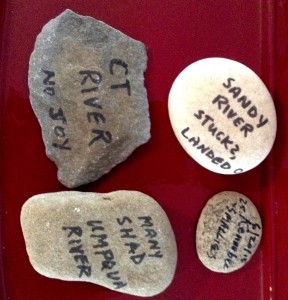
For paperweights, I use the rocks I’ve brought from places I’ve fished, each with a hand-painted legend telling me how I did: “Umpqua River, many shad;” “Deschutes, stuck 2 , landed 1.” Aids to memory, they carry the freight of friends and rivers and time spent in the one church I recognize, the outdoors. My rocks remind me that work and leisure do not conflict but complement, and when I try to bull on through a piece instead of trying to flow with it, I don’t do my best work.
A grandmother’s smirk
One more photograph sits on the desk: my wife’s grandmother celebrating her 93d birthday, her tongue stuck out at the camera. This woman who never dressed in a color but purple and refused the Boston Post Cane when it was offered her (not wanting to be identified as the oldest resident in town) was a devoted Red Sox fan, thus patron of lost causes. (Sadly, she died before 2004). She and her daughter-in-law’s mother listened to games together in their separate houses, the party line open between them for commentary. Her presence in my work place reminds me that too much seriousness is poison, that I need to allow myself to be joyful and loose, however I can manage – I need to take chances with my dignity.
Meditating Mary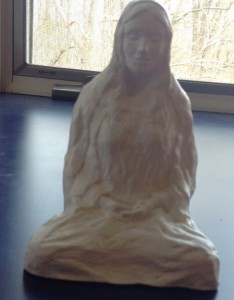
Last on the desk sits a white cast resin statue of the Virgin Mary meditating in the lotus position, the original sculpted by my friend Matt Lyon. Matt, the only Buddhist monk I’ve ever drunk Guinness with, died when he laid down his motorcycle in front of a car that ran a Stop sign. Knowing he would likely die, his last impulse was to keep the long line of vehicles behind him from piling up, causing more casualties than his own. Matt’s Mary reminds me to surrender myself once in a while, not hold myself or my work so important it can’t be sacrificed for something larger. And it tells me the intention of a prayer is far more important than the form.
David Mamet said once in an interview: “Being a writer is so ethereal that I think most of us tend to surround ourselves with tchotchkes so we can actually be sure we have a past.”
“Tchotchkes” is too flippant a name for my charms – that might leach their magic – but I understand what he says. The items we travel with choose our various pasts, our presents and futures. And even when I do not see myself whole in my work, I trust my amulets to push me every day. This is what I strive for: a place where my love for the work and my need to do it are united, the place where the things that carry me abide.
March 21, 2016
Popular History: You Can’t Judge a Book by its Publisher
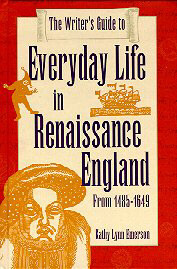 Kaitlyn Dunnett/Kathy Lynn Emerson here, offering a few observations based on having read (or at least skimmed) just about every nonfiction book on Tudor history and most Tudor biographies that have come out in the last 40 years in search of subjects to add to my online “A Who’s Who of Tudor Women” (now over 2000 mini-biographies of women who spent at least part of their lives in England between 1485 and 1603) and as research for my novels.
Kaitlyn Dunnett/Kathy Lynn Emerson here, offering a few observations based on having read (or at least skimmed) just about every nonfiction book on Tudor history and most Tudor biographies that have come out in the last 40 years in search of subjects to add to my online “A Who’s Who of Tudor Women” (now over 2000 mini-biographies of women who spent at least part of their lives in England between 1485 and 1603) and as research for my novels.
Observation One: Well trained scholars (“experts”) can get things wrong. I have read very few scholarly books in which I didn’t spot some error, mostly to do with minor historical persons. The author simply didn’t care enough about these people to check for more recent research and just repeated the accepted “facts.” Worst example? In an otherwise well-researched book on Tudor life, the author claimed, in the chapter on food, that stews were outlawed by Henry VIII. Well, they were, but the “stews” in question were brothels, not the kind you cook in a pot.
Observation Two: Scholars writing for publication almost always have an agenda. To prove a point, they sometimes ignore inconvenient documents and/or theories.
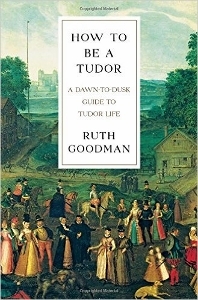 Observation Three: Most historical “facts” are subject to change as new or overlooked documents come to light and old ones are reinterpreted. A recent article by living history expert Ruth Goodman explains why Tudor people, despite avoiding baths, did not, in fact, stink. After reading this article, I ordered her How to Be a Tudor and it turned out to be the best book on everyday life in the sixteenth century I have ever read, and that includes the one I wrote for Writers Digest Books back in 1996.
Observation Three: Most historical “facts” are subject to change as new or overlooked documents come to light and old ones are reinterpreted. A recent article by living history expert Ruth Goodman explains why Tudor people, despite avoiding baths, did not, in fact, stink. After reading this article, I ordered her How to Be a Tudor and it turned out to be the best book on everyday life in the sixteenth century I have ever read, and that includes the one I wrote for Writers Digest Books back in 1996.
Observation Four: When there are two or more interpretations of some historic event, novelists are allowed to pick the one that works best for their stories.
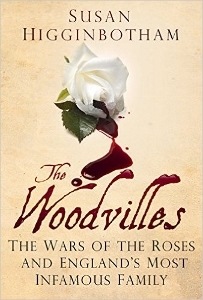 Observation Five: Some of the most interesting material (to me, anyway) comes to light because an independent scholar or an amateur historian interested in one particular aspect of history took the trouble to dig deep and find information overlooked by more scholarly individuals. A recent biography of George Boleyn (George Boleyn: Tudor Poet, Courtier & Diplomat by Claire Cherry and Claire Ridgway) had its origins in a website, “The Anne Boleyn Files.” The Woodvilles was written by historical novelist Susan Higginbotham because no one else had written a history of this fascinating family.
Observation Five: Some of the most interesting material (to me, anyway) comes to light because an independent scholar or an amateur historian interested in one particular aspect of history took the trouble to dig deep and find information overlooked by more scholarly individuals. A recent biography of George Boleyn (George Boleyn: Tudor Poet, Courtier & Diplomat by Claire Cherry and Claire Ridgway) had its origins in a website, “The Anne Boleyn Files.” The Woodvilles was written by historical novelist Susan Higginbotham because no one else had written a history of this fascinating family.
Observation Six: Amateur genealogists also have something to offer. They have a highly personal reason to dig deeper. I found fascinating details on horses in Tudor times in a self-published book from 1990, The Marriage That Did Succeed for Mary Queen of Scots by James Walter Deppa. His ancestors include one of Mary Stewart’s ladies and a young man who worked in the queen’s stables.
Observation Seven: “Popular” histories contain lots of domestic details and, well, gossip, and are what pique most people’s interested in history in the first place. Yes, some of these are cranked out just to take advantage of, say, renewed interest in Henry VIII generated by The Tudors, and some of their authors leap to pretty far-fetched conclusions; but, with luck, they prompt their readers to continue delving into the subject matter. Books by A. L. Rowse, back in the day, fed my interest in the Tudor period. Today, Alison Weir’s biographies do the same thing and her Henry VIII: The King and his Court is a great place for fiction writers to find those telling details that bring a story to life.
Observation Eight: Yes, there are errors in books written by popular historians, and they sometimes draw illogical conclusions, but even the ones that are full of wrong assumptions (every single book I’ve seen that claims to tell you the real story of Henry VIII’s mistresses, for example) contain material of interest, particularly if you are doing research for a novel.
 Observation Nine: When novelists write about real people’s private lives, they owe it to those long-dead individuals to consider all the known facts. Philippa Gregory used Retha Warnicke’s controversial The Rise and Fall of Anne Boleyn as her source for The Other Boleyn Girl. Obviously, this didn’t hurt sales, but in my personal opinion it did a great disservice to at least one minor historical figure. In her book, Warnicke makes several claims that are widely disputed by other scholars who have more logical and fact-based arguments to back them up than she does.
Observation Nine: When novelists write about real people’s private lives, they owe it to those long-dead individuals to consider all the known facts. Philippa Gregory used Retha Warnicke’s controversial The Rise and Fall of Anne Boleyn as her source for The Other Boleyn Girl. Obviously, this didn’t hurt sales, but in my personal opinion it did a great disservice to at least one minor historical figure. In her book, Warnicke makes several claims that are widely disputed by other scholars who have more logical and fact-based arguments to back them up than she does.
Observation Ten: When writing about a real person, if there is a segment of that person’s life during which no one knows where they were or what they were doing, then the novelist is free to extrapolate from the facts and write about what might have happened. Here’s the thing: novels are fiction. In fact, for those really willing to suspend disbelief, there are some excellent alternate history/fantasy novels out there. To name just two, Queen Elizabeth the First fights vampires in The Secret History of Elizabeth Tudor, Vampire Slayer by Lucy Weston, and Anne Boleyn gives King Henry a son who grows to adulthood and inherits the throne in Laura Andersen’s The Boleyn King, the first of a trilogy.
Kathy Lynn Emerson/Kaitlyn Dunnett is the author of over fifty books written under several names. She won the Agatha Award in 2008 for best mystery nonfiction for How to Write Killer Historical Mysteries and was an Agatha Award finalist in 2014 in the best mystery short story category for “The Blessing Witch.” Currently she writes the contemporary Liss MacCrimmon Mysteries (The Scottie Barked at Midnight) as Kaitlyn and the historical Mistress Jaffrey Mysteries (Murder in the Merchant’s Hall) as Kathy. The latter series is a spin-off from her earlier “Face Down” series and is set in Elizabethan England. Her websites are www.KaitlynDunnett.com and www.KathyLynnEmerson.com And, if you are interested in reading about the real women who lived in England in Tudor Times, click here to go to the index for “A Who’s Who of Tudor Women”
March 20, 2016
Iterative Versus Linear Processes in Publishing
By Barb, who has made it back to New England in time for our very last snow, apparently
Last week, as I read Jane Friedman’s excellent blog post on the takeaways for authors from Digital Book World, I was struck once again by the idea that traditional publishers are stuck in a world of linear manufacturing processes when, in fact, it is their iterative processes they need to embrace to survive.
Development versus Manufacturing
In my previous life I worked as a Chief Operating Officer for an educational technology company that developed and distributed software that institutions of higher education used to put courses, or even more often, to put some course functions (self-quizzing, grading, submission of papers, etc.) online. At this company, we partnered with the big textbook publishers and in those days (1996-2006), despite the fact that one of those publishers had a large investment stake in our company and a seat on the board, the relationships were fraught.
After struggling for years with hysteria on one side or the other, I realized that one of the major problems between a software company like ours and the textbook publishers was that our processes were almost all iterative, whereas theirs were linear.
In the software world, particularly when you are creating a new category of product, you normally put out a version that has your best guess as to what your target users want and need. You see if customers or users rally to it (i.e. if it’s even worth investing more time and money in). If users do like it, believe me, they’ll tell you in no uncertain terms what other features they need and where the bugs are. The work of fixing the current version and creating new versions is constant, all part of a conversation with customers and users. Cycles have shrunk and gone faster even since I stepped out of the field in 2010.
At the publishers, the editors worked under a very different burden. Each edition of the book was an endpoint and it had to be absolutely perfect. At least that was the goal. This was the product that their salespeople would carry around in the trunks of their cars for the next three years. No changes.
Our very different mindsets about how we were working and the goals of our processes caused a huge amount of our conflict. (Earlier this month, McGraw-Hill announced that sales 2015 unit sales of digital platforms and programs exceeded those of print in its U.S. Higher Education Group for the first time. I imagine the culture has changed there, too.)
What does that have to do with fiction?
Producing quality fiction books requires both iterative and linear processes.
When we think of the great era of book editors, we think of a conversation between a writer and editor that shaped a book and made it great. Iterative processes are inherently creative processes.
But often publishers think like manufacturers. Ask anyone who’s ever tried to get an error in a book changed, even in the digital version. Or tried make a significant change at the galley stage. Galleys are treated as if they are typeset in printer’s trays the way my great-grandfather used to do it. “I don’t know how you do it,” a friend of mine told her editor, “but I’m using a computer.”
I realize that every time they open a file on a computer, it costs a publisher money. But the linear mindset causes publishers not to do things that are easy and cheap. Like fixing a book’s metadata after it’s released. Or adding a buy link for the next book in a series into a published ebook. What better, cheaper, more targeted form of advertising? Or dropping the price of the e-book for a time period. Some publishers act as if the price is still printed on the cover. As Friedman points out in her report, they can always raise it again.
But doing things like that involves changing your mindset to realize that producing the book is no longer an endpoint and paying attention to the book long after the traditional short promotional period that follows a book’s release. Many traditional publishers haven’t shown themselves to be great at that.
No, I don’t want novels to become like software with changes constantly made based on readers’ suggestions. There are other methods of storytelling that support that approach better, including interactive gaming and forms of experimental fiction. The novel’s strength is that it is one person’s vision and it is inevitably shaped by the time in which it is written. (One of my favorite series is Jasper Fforde’s Thursday Next books in which the canon must constantly be repaired from damage caused by wandering literary tourists.)
But I do think it’s the iterative processes at publishing houses that are the valuable ones—curating their list, and making those books the best they can be. Technology will make the manufacturing part of producing books ever faster and more cost-efficient. We’ve already reached the point where printing access and costs are not barriers to entry for anyone. Can they big publishers change their mindsets? It will be interesting to watch.
Usual caveats:
I actually have a great relationship with my publisher. As a medium-sized house they’ve shown themselves willing to experiment with pricing and marketing in many ways, including changing ebook pricing long after a book’s release.
Authors are not really insiders when it comes to publishing. We’re not at the table when the important decisions get made. So you should view these opinions only as those of a highly interested observer.
March 18, 2016
Weekend Update: March 19-20, 2016
 Next week at Maine Crime Writers there will be posts by Barb Ross (Monday), Kaitlyn Dunnett/Kathy Lynn Emerson (Tuesday), Dick Cass (Wednesday), Maureen Milliken (Thursday), and Kate Flora (Friday).
Next week at Maine Crime Writers there will be posts by Barb Ross (Monday), Kaitlyn Dunnett/Kathy Lynn Emerson (Tuesday), Dick Cass (Wednesday), Maureen Milliken (Thursday), and Kate Flora (Friday).
In the news department, here’s what’s happening with some of us who blog regularly at Maine Crime Writers:
Barb: Hi. There’s another great review of Best New England Crime Stories: Red Dawn up on George Smith’s Maine blog, with shout-outs to several Maine Crime Writers, including Kate Flora, Dorothy Cannell and Bruce Coffin. http://www.georgesmithmaine.com/articles/book-reviews/march/2016/red-dawn-delivers-great-new-england-crime-stories.
Meanwhile, after a long winter, who will I get to see at the Maine Crime Wave?
Kathy: Speaking of Maine Crime Wave. There is also “Two Minutes in the Slammer” the night before. Want to see how people react to a short reading from your work-in-progress? Here’s your chance. There are still slots open on the schedule. I did this last year and not only was it great fun, it gave me the opportunity to get a glimpse of what other folks were writing. At least two of those talented people have signed book contracts since then.
+ MAINE CRIME WAVE http://mainewriters.org/2016-maine-crime-wave/
+ SCHEDULE http://mainewriters.dreamhosters.com/?page_id=3223
+ PANELISTS & WORKSHOP LEADERS http://mainewriters.org/panelists-workshop-leaders/
+ REGISTRATION DUE April 5, 2016
+ TWO MINUTES IN THE SLAMMER Open Mic Reading Friday, April 8

An invitation to readers of this blog: Do you have news relating to Maine, Crime, or Writing? We’d love to hear from you. Just comment below to share.
And a reminder: If your library, school, or organization is looking for a speaker, we are often available to talk about the writing process, research, where we get our ideas, and other mysteries of the business. Contact Kate Flora: mailto: kateflora@gmail.com
March 17, 2016
Ten Things You Don’t Know About My Writing Journey
Lea Wait, here, suspecting you’re reading this because you know me, or you know my books, or you love mysteries, or write them, or you have nothing scheduled for the next few minutes. 
So, I thought today I’d share a little bit about how I got to where I am. I’ll focus on my writing, not on all of my life. (My life would take at least two blogs.)
I decided to be a writer when I was in second grade. I kept escaping my classroom to the library (never one to set low goals, I’d decided to read every book in the library) and my teacher had a serious talk with me. “When you grow up you can be a writer, and spend all your time in the library. But first you have to finish second grade.” From that point on I told everyone I was going to be a writer.
A little later on I was editor of my high school newspaper, which won an award from the New Jersey Press Association for being the best high school newspaper in New Jersey that year.
I spent one summer in high school working at The Boothbay Register, a weekly paper in Maine that’s still around. My job was to proofread, walk around town to pick up ads, and remind local columnists if their columns were late. One of the men I worked with pinched. (Welcome to the adult world!)
I majored in English and drama in college, since I couldn’t decide which one I liked better. I wrote plays for children’s theatre and poetry. Several of the plays were produced on campus, and one of my poems won a national award. Marianne Moore was the judge of the poetry contest; she praised my work, and I was thrilled. (The poem is on my website (see “Ellie Poem” under “Books”) and is used in high school and college classes in several countries today.)
My first post-college job was as an executive speech writer at a now-defunct company called Western Electric, which manufactured telephones and other equipment for the old Bell System. When I was given my first assignment on the executive floor, the secretaries there wouldn’t let me in. They didn’t believe a woman could be a speechwriter.
Later I worked for AT&T and for two years was the producer, writer, and on-camera talent for a daily CCTV show for employees in New York City and New Jersey.
My master’s thesis (New York University) was on the changing role of the mother in fiction for teenagers written from 1950–1955 and 1960-1965. (As I remember, most of the 100 books I read focused on team sports or getting a date for the prom.)
My daughters, Xmas, 1987
For about ten years, as the single adoptive parent of four and advocate for older child and single parent adoption, I wrote a bimonthly adoption newsletter for adoptive parents and prospective parents, and contributed articles on adoption to anthologies.
My first published fiction was a short story from the point of view of a fourteen-year-old girl giving birth to a child with Down Syndrome. It was published in a literary magazine called Happy.
And the first full book I wrote, a mystery, was rejected by over forty agents. Eventually, about six years later, it was published by Scribner as Shadows at the Fair, and was a finalist for a “best first” Agatha. It wasn’t the first book I’d had published, though. That was a book for ages 8-12 set in 1806 Maine called Stopping to Home.
I’ve had sixteen books published since Stopping to Home in 2001, and two more, one in each of my mystery series, will be published next fall: Shadows on a Morning in Maine in September, and Dangling By a Thread in November.
And I’m still writing. The journey continues ….. thank you for coming along!
March 16, 2016
Do You Suffer From Postnovel Depression?
Vaughn C. Hardacker here: I just finished the rewrite of a novel and sent it off to my editor. Now I find myself deep in the doldrums of what I call Postnovel Depression. The closest thing I can equate it to is the postpartum depression some mothers experience  after birth of a child. I mope around and check email thirty or forty times a day looking for those cherished words from my editor: “Can I send you a contract?”
after birth of a child. I mope around and check email thirty or forty times a day looking for those cherished words from my editor: “Can I send you a contract?”
I close email and open scrivener to work on a new novel and after several moments, close scrivener and check email. I tell my self to relax and stop being ridiculous…it takes time for an editor to work through the slush pile to get to my manuscript and more time for him to read it. I hate that word: TIME! I mutter, moan, and curse. I complain that if all industries moved at the pace of the publishing industry, the Industrial Revolution would only still be a future event.
I tell myself not to get too upset, what is; is and all writers go through the same thing (Have I mentioned that I suffer from grandiosity? Of course I’m the only writer who goes through this!). So I check email again…
This goes on for a week or more until I start believing that I’ll never again complete a novel. I open scrivener to work on a new novel and after several moments, close scrivener and check email. (Is this starting to sound like the script of Groundhog Day?) I mutter, moan, and curse…
Finally, usually late at night, I have an epiphany and open scrivener–this time I start developing character sheets for my antagonist (in a series there isn’t much to do with protagonists, especially after the first couple of books) and the various settings in which the story will take place. Voila! I start chapter one and I’m off and running.
I completely ignore the fact that at the end of the book Postnovel Depression is waiting for me, after all aren’t our books and the characters in them our children? Of course, you probably have no idea of what I’m speaking. This only happens to me! (Have I mentioned that I suffer fr om grandiosity?)
om grandiosity?)
By the time this post goes live, THE BLACK ORCHID, will have been released and I will be at a book launch party at the Jesup Memorial Library, 34 Mt Desert St, Bar Harbor, ME 04609. If you’re in the neighborhood, stop by.
Vaughn C. Hardacker is the author of three thrillers: SNIPER (finalist for 2015 Maine Literary Award in Crime Fiction category), THE FISHERMAN, and THE BLACK ORCHID (released March 2016). He lives in Stockholm, ME which he describes as being “five minute south of the end of civilization as we know it.” He does however, visit the United States several times each year.
March 15, 2016
Keepers of the Flock: Reflections on Feeding Wild Birds
Jen Blood here, on a rainy evening of reflection after a rainy day of much of the same here in Maine. These days I live in Cushing, a little fishing village in the mid-coast, where I’ve rented a house with my mom for the past three years. While there are, inevitably, challenges to living with a parent when one is an adult, she’s quite a kick to hang out with, and there’s been something kind of wonderful about reconnecting these past few years. I’m 42 now, which means I’m becoming increasingly aware of that inevitable, onward march of time. I’ll be moving on to new digs come spring, so in anticipation of that, I’ve been getting a little sentimental about the things I’ll miss about this latest home of mine.
One of my favorite parts of this place is the deck just outside our back door, which looks out on an expansive lawn and a pond perfect for ducks, geese, trout, and turtles. My mom is a big fan of birds, so last year I went a little nuts and bought feeders and a bird bath, bird houses and birdseed, suet and flowers and bright red hummingbird feeders. The birds, naturally, were psyched about the arrangement. Over the course of the summer, we watched two batches of robins nest, an exhausted papa robin feeding the babies until they were plump little fuzzballs just testing their wings.
We watched house finches nest on the other side of the porch, their antics once the babies were grown riotous to watch. There were hummingbirds and woodpeckers, cardinals, goldfinches, chickadees and nuthatches and red-winged blackbirds and tufted titmice (if you, like me, are not convinced titmice is the correct word, see this great post at Bird Watcher’s General Store). There were, in other words, a lot of birds.
Because I love animals and try to be a good steward of the planet, feeding this many birds naturally led to the question: Should I actually be feeding wild birds? I’ve been taught since I was little not to feed the bears at the zoo or the raccoons in my yard, regardless of how cuddly they might look. Which, let me tell you, was not a popular position when I was seven. That’s not just for my well-being, however; it’s for theirs. 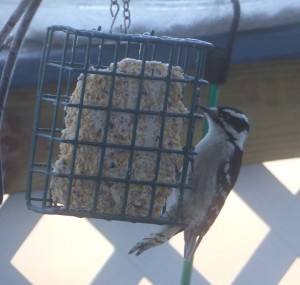 But, try as I might, I haven’t found anything definitive telling me that feeding the birds is a bad thing. There’s no question that it’s quite the industry: “Households in the United States and the United Kingdom put out over 1 billion pounds of food, including seeds, bread and even peanuts, for backyard birds each year,” according to this article at www.livescience.com. The same article cites a 2008 study done by a team of researchers from the University of Exeter and Queen’s University Belfast, which came to the conclusion that, “The birds given more to snack on in the winter months laid eggs earlier than the birds in the other group, and they had an average of one more nestling that flew away from the nest successfully.” In other words… Feeding wild birds is not only okay, it’s good for them. At least, it is according to that single study — I’m sure there are dissenters.
But, try as I might, I haven’t found anything definitive telling me that feeding the birds is a bad thing. There’s no question that it’s quite the industry: “Households in the United States and the United Kingdom put out over 1 billion pounds of food, including seeds, bread and even peanuts, for backyard birds each year,” according to this article at www.livescience.com. The same article cites a 2008 study done by a team of researchers from the University of Exeter and Queen’s University Belfast, which came to the conclusion that, “The birds given more to snack on in the winter months laid eggs earlier than the birds in the other group, and they had an average of one more nestling that flew away from the nest successfully.” In other words… Feeding wild birds is not only okay, it’s good for them. At least, it is according to that single study — I’m sure there are dissenters.
There is some disagreement as to whether it’s wise to continue feeding wild birds during the spring and summer months, but the Cornell Lab of Ornithology takes the position that it’s fine as long as you keep things clean.
 Between my mom and I, we’ve managed to do that, and these days find ourselves keepers of a diverse flock. In the mornings when I’m here, I have a set routine in which I take my pup Killian out for a walk around the back forty, come in and make breakfast, and then — before sitting down to eat — go outside to feed the birds. Right now, that means black oil sunflower seeds, wild bird food, and roasted, unsalted peanuts still in the shell. After doing this for months, I’ve become accustomed to the routine once the food is out and I’m back inside, though I still get a kick once I see the first chickadee wend its way to the railing. That sole chickadee seems to provide a signal to the others.
Between my mom and I, we’ve managed to do that, and these days find ourselves keepers of a diverse flock. In the mornings when I’m here, I have a set routine in which I take my pup Killian out for a walk around the back forty, come in and make breakfast, and then — before sitting down to eat — go outside to feed the birds. Right now, that means black oil sunflower seeds, wild bird food, and roasted, unsalted peanuts still in the shell. After doing this for months, I’ve become accustomed to the routine once the food is out and I’m back inside, though I still get a kick once I see the first chickadee wend its way to the railing. That sole chickadee seems to provide a signal to the others.
 The blue jays — who are huge fans of the peanuts — swoop in next, cramming one peanut down their gullet before grabbing another to fit in its beak. Woodpeckers head for the suet. Cardinals, titmice, finches, and nuthatches sweep in when there’s an opening, but everyone takes off when the mourning doves head in. The mourning doves and red-winged blackbirds have become something of an issue, so we’ve set things up now so that the feeders — which discourage larger birds — are on one end of the deck, suet hangs from the trees, and a couple of open feeders on the other end of the deck hold black-oil sunflower seeds for the big guys. It’s kind of a zoo, to be honest.
The blue jays — who are huge fans of the peanuts — swoop in next, cramming one peanut down their gullet before grabbing another to fit in its beak. Woodpeckers head for the suet. Cardinals, titmice, finches, and nuthatches sweep in when there’s an opening, but everyone takes off when the mourning doves head in. The mourning doves and red-winged blackbirds have become something of an issue, so we’ve set things up now so that the feeders — which discourage larger birds — are on one end of the deck, suet hangs from the trees, and a couple of open feeders on the other end of the deck hold black-oil sunflower seeds for the big guys. It’s kind of a zoo, to be honest.
 But, it is — however temporarily — my zoo, and the mornings that I’ve spent watching the birds and the squirrels and the chipmunks lobby for position at the feeders, talking to my mom about life, death, taxes, and the latest episode of The Voice, are mornings that I expect will become treasured memories in the years to come. So, here’s to the winged creatures of the world, and the quiet moments of peace and reflection they bring us.
But, it is — however temporarily — my zoo, and the mornings that I’ve spent watching the birds and the squirrels and the chipmunks lobby for position at the feeders, talking to my mom about life, death, taxes, and the latest episode of The Voice, are mornings that I expect will become treasured memories in the years to come. So, here’s to the winged creatures of the world, and the quiet moments of peace and reflection they bring us.
What about you? Do you have bird feeders at your place, or are you of the mind that wild things are better left to their own devices?
March 14, 2016
My Dance of Fame
By Brenda Buchanan
Nobody writes songs about March. In New England at least, the third month is long on gray and short on poetry. This year is the exception to the rule—warm days having begat bare ground and the early arrival of crocus and daffodil shoots. But more years than not, March is the dreggy end of winter, a 31-day slog of grubby snowbanks and freeze-thaw-freeze cycles.
If not for St. Patrick’s Day, March would have little to recommend it.
In my family, the holiday is a big deal. My mother and her siblings were born in America but my older relatives had brogues as thick as spring fog. Determined to hang on to their culture, they maintained certain traditions including teaching children (especially little girls) to step dance.
My older sister and I took lessons from a woman named Bernadette, who was off the boat from County Kerry. Irish step dancing involves complicated footwork. In her Saturday morning classes, Bernadette called out cues I remember to this day. Heel, toe, heel, toe, heel, toe, hop one-two-three-four. A jig or a reel played in the background, helping little feet keep the beat.
The more difficult skill for me was to keep my hands at my sides, fingertips pointing to the floor. That is a defining aspect of traditional Irish step dance, intended to direct attention to the intricate steps. My little sister—who when I first started would have been two to my four—was too young to dance but old enough to keep me in line. Kate sat in the front row during practice sessions and called me out when my arms flew out from my sides. “Hands!” she’d chirp. “Hands!”
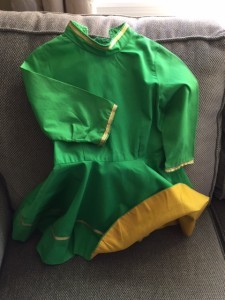
One of the little dresses my mother made. Note the gold fabric on the underside of the skirt, which made for flashy kicks.
Thoughout the year, but especially in March, Bernadette’s troupe danced at various events around town. Our mothers made our outfits, green dresses with gold fabric on the underside of the skirt, designed to show when we kicked our tap-shoed feet. Somehow I have hung on to one of mine all these years. There it is at right, in all its tiny glory.
Our shoes were tied with Kelly green ribbons. On our legs we wore black tights. A back sash was pinned from left shoulder to right hip.
Such was the costume we wore the night a dozen or so of us were to be the entertainment at the 1962 St. Patrick’s Day party sponsored by the city’s Irish-American Club. We were the warm-up act for Ted Kennedy, who had just announced his first candidacy for United States Senate. His brother was president, of course, which made this gig a Very Big Deal to the older girls in the troupe. At the end of our performance we’d been instructed by Bernadette to skip down the stairs on the side of the stage—tallest to shortest—and shake the hand of the candidate, who was sitting in the front row. The oldest girl—my second cousin—had a small token of some sort to present to him as a gift from us.
I was four years old—too young to be nervous about anything but keeping my hands by my sides—but backstage jitters infected the big girls. We’d be dancing for the handsome president’s handsome younger brother, not to mention a hall packed with most of the Irish population of Fitchburg. The young teenagers were wound up. Moments before we went on one of them sidled over to me and said the plan had changed, I was now going to lead the troupe off the stage and be the one to hand the gift to Mr. Kennedy.
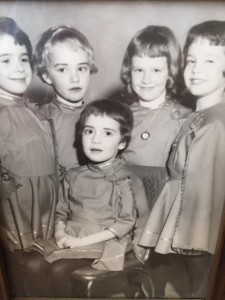
I suspect this photo was taken a year or two after the famous Irish-American Club party. I am seated. My sister SuEllen is the fair-haired girl second from left.
So out we went and dance we did and after we took our bow I led the way off the stage. Whenever my mother told this story she’d put her hand over her heart and exclaim that her relief at our fine performance gave way to dismay that her headstrong little Brenda was leading the march to Ted Kennedy instead of bringing up the rear. My memory is that he was very nice and people took pictures of all of us, then my older sister and I were whisked home because by then it was long past our bedtime.
The next day a telegram arrived at our house (yep, an actual telegram.) It read: My brother tells me you are the best step-dancers ever. STOP. Congratulations! STOP. It was signed JFK. Now that impressed me. I may not have quite grasped who the man in the front row of the audience was, but I knew JFK was President of the United States.
I was probably 12 before I learned that the telegram had been sent by my uncle, John Francis Kane.
Happy St. Patrick’s Day to all of the readers of this blog. My gift to you is this link to the fabulous McNiff Irish Dancers, performing in 1958. These dancers were the real deal. They performed on the Ed Sullivan show, not merely at hometown St. Patrick’s Day dinners. But we danced this same traditional style. Note that except for the parts when the piece called for them to clasp hands, the dancers’ fingers are pointed right at their tap shoes.
P.S. In my family, the tradition continues to this day. This week my five-year-old grandniece Caeley danced in her first recital.
Baseball, Politics, and Reason
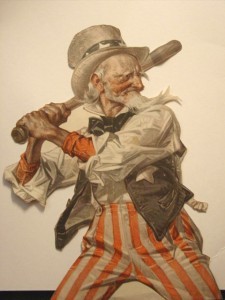
Here Comes the Curve
Bruce Robert Coffin here, filling in for Chris Holm who is immersed in editing his latest novel. It might seem as though I’m doing Chris a favor but in reality I have an ulterior motive. The truth is I loved Chris’s last novel, The Killing Kind, now I’m dying to read the sequel, Red Right Hand. Hurry up, Chris!
This week I’m going where nobody in their right mind would intentionally go. Join me, won’t you?
Spring training is in full swing (hit ‘em with a bad pun right out of the gate)(Hey, Dick Cass, since I no longer have NESN maybe you could invite me over to watch a game once in a while, just sayin’). I’ll be honest with you, I am a diehard Red Sox fan. Always have been, always will be. I’ll confess that I have a number of friends who are Yankee fans. Poor misguided folks. But I still love ‘em. Maybe one day they’ll come around.
The love of one’s team is a point of much discord. There’s nothing rational about it. We consider our team the best and we want to see them win. Every time. Sox fans throw around comments like: “Yankees suck” and “Bronx Bums.” Likewise, New York fans quip eloquently: “Sox Suck” and “Beantown Bums.” It gets nasty. As fans (an interesting abbreviated form of the word fanatical) of the game we often get into spirited discussions leading to putdowns and mud slinging. But, when it comes right down to it, what are we really doing? We don’t personally know any of the players. We’ve got no stake in how the game turns out. It’s not like we own these teams. No, the reality is we’re cheering for and spending our hard earned money on a bunch of out of touch grown men, strangers, who are paid millions of dollars, win or lose, to play a game. Period. We buy shirts, pennants, bumper stickers, and hats. Almost seems nonsensical. Almost.
Which brings me to my next point. Politics. The presidential race. The most watched, read about, and bandied about of all the races. The run for the highest office in the land. Leader of the free world. This is big time. The world is watching. And unlike baseball, much is at stake (sorry Red Sox Nation). Our very existence rides on the winner of the brass ring (I read it in the newspaper). Do you realize that our next president might well be charged with nominating not one but several Supreme Court justices? (But that’s a whole different topic for another day). And like baseball, everyone has an opinion. Some folks despise Hillary, some despise Trump, some aren’t quite feelin’ the Bern. I’ve heard some say that they don’t like any of the front runners, that they’d much rather have someone a bit more moderate in the White House. It’s a divisive world we live in. America has many problems. On this point I think most of us would agree.
I keep hearing people say that this country has never been more divided. That it’s getting scary. Really? I have two words for you, Civil War. Hard to imagine a country more divided than one whose citizens would take up arms against each other. And mud slinging? Nothing new here either. Thomas Paine once described George Washington thusly: A man of “grossest adulation,” a “hypocrite,” “incapable of friendship.” In 1800 President John Adams found himself running against his own Vice President, Thomas Jefferson. Jefferson’s campaign referred to Adams as a fool, criminal, and a tyrant. While Adam’s people labeled Jefferson a weakling, atheist, libertine, and a coward. Interesting side note, both men were life long friends before the election, and again following the election… Hmm. Showmanship?
Historically, even First Ladies have gotten in on the action. Martha Washington called Jefferson “one of the most detestable of mankind.” Take that you wearer of support hose!
While all of this muckraking is nothing new to our relatively young country, it is a bit over the top. Our society does seem way too obsessed with so called “reality television.” And I’m not talking about the informative kind, I’m refering to the shows where the only entertainment value comes from watching people get beat down and belittled. The shows whose contestants are labeled the weakest link, or told that they’re fired, or that the food they’ve prepared tastes like garbage. Somehow it’s become the norm to disrespect others and get excited watching it on the tube. Given our fascination with this negative programming, is it any wonder that the front runners of both major political parties are causing many to shake their heads in wonder. If we as a society live for this negativity and mudslinging doesn’t it stand to reason that your choices for president would be representative of this. Moderates don’t rise to the top. Polarization is the name of the game folks. Stand at the far right or far left of every issue and you’ll get noticed. I guarantee it. By both sides.
Moving right along, let’s discuss reason. This may come as a shock but we don’t all get to have our way all of the time. That’s life. If we really want our nation to lead by example we must except this. Compromise is a trait that all of the greatest politicians employed. If we as Americans are no longer willing to compromise, traffic intersections deemed four-way-stops are about to become a lot more dangerous. Hey, I was here first!
And enough with the name calling. Seriously. I disagree in principal with many of my friends and relatives on a variety of issues, but guess what? They’re still my friends and relatives. We can agree to disagree. I’ll not engage in belittling or name calling over difference of opinion. This isn’t first grade. If I were to believe all of the rhetoric of social media pundits, I’d have to conclude that all Republicans, or Rethuglican’s, are wing nuts, lunatics, ideologues, and extremists out to destroy the country. Likewise, at least according to the social media experts, all Democrats, or Demoncats, are moonbats, morons, hacks, and extremists out to destroy our country. Extremist? Hey, can both parties be slandered with the same term? Folks, we may have found common ground here!
This isn’t another attempt to try and tell you what you should be for or against. There’s been far too much of that. I’m not writing this to try and sway your opinions. If you’re passionate about your beliefs, good for you. I get pretty passionate about some of my beliefs, too. All I’m asking is that we take a step back. Stop waving our fists in each other’s faces long enough to recognize that it’s okay to disagree. Our opinions are generally based upon our life experiences. Rarely are those experiences exactly the same. My position on many of today’s issues have changed as I’ve grown older (and not necessarily wiser).
Remember what I said about baseball players? Out of touch millionaires playing a game. Sound familiar?
To those of you who are happy with your party’s front runner I say congratulations and best of luck in November. To those of you who think your party can do a whole lot better I say perhaps it’s time to lead by example.
Go Sox!
March 11, 2016
Weekend Update: March 12-13, 2016
 Next week at Maine Crime Writers there will be posts by Bruce Coffin(Monday), Brenda Buchanan (Tuesday), Jen Blood (Wednesday), Vaughn Hardacker (Thursday), and Lea Wait Friday).
Next week at Maine Crime Writers there will be posts by Bruce Coffin(Monday), Brenda Buchanan (Tuesday), Jen Blood (Wednesday), Vaughn Hardacker (Thursday), and Lea Wait Friday).
In the news department, here’s what’s happening with some of us who blog regularly at Maine Crime Writers:
from Lea Wait: On Tuesday and Wednesday of this week I’ll be visiting the Hermon Middle School (in Hermon, Maine.) I love making school visits! I’ll be talking to classes about my historical novels set in Maine, addressing an all-school assembly, and running three writing workshops. Busy days — but always refreshing to spend time with young readers (and writers.)
from Kaitlyn Dunnett/Kathy Lynn Emerson: Just to give folks in the area near Longmeadow, MA a head’s up, I’ll be participating in a mystery writers panel at the Storrs Library on Monday, April 4th, with Susannah Hardy/Sadie Harwell and Sharon Healy-Yang. The program starts at 6:30 PM and will run for about an hour and we’ll be selling and signing our books afterward. You can find the library’s website at longmeadowlibrary.org There is a form there if you want to register in advance to attend the program, but we won’t turn away anyone who decides to come at the last minute.
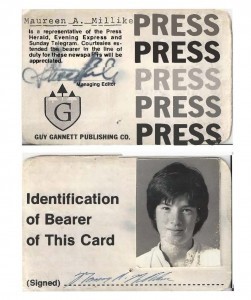 from Maureen Milliken: April is turning out to be the coolest month for me (see what I did there, English majors?). The latest development is that 0n April 27, I’ll be talking about Journalism and Writing at the Belgrade Public Library in Belgrade, Maine. The library asked me this week, saying that patrons are familiar both with my work as a columnist for the Morning Sentinel and Kennebec Journal, as well as my mystery novel Cold Hard News, which, of course, the library has on its shelves. The big question is, does more than 30 years as a journalist provide any kind of foundation at all for a mystery writing career? We’ll find out! I’m looking forward to the answer, too.
from Maureen Milliken: April is turning out to be the coolest month for me (see what I did there, English majors?). The latest development is that 0n April 27, I’ll be talking about Journalism and Writing at the Belgrade Public Library in Belgrade, Maine. The library asked me this week, saying that patrons are familiar both with my work as a columnist for the Morning Sentinel and Kennebec Journal, as well as my mystery novel Cold Hard News, which, of course, the library has on its shelves. The big question is, does more than 30 years as a journalist provide any kind of foundation at all for a mystery writing career? We’ll find out! I’m looking forward to the answer, too.
This joins a number of other upcoming events including one at my childhood library Lithgow, in Augusta, Maine; a panel appearance at Maine Crime Wave on April 9, reading from No News Is Bad News, the second in the Bernie O’Dea mystery series and due out this summer, as well as several other cool events. For details and/or to sign up for my “weekly” emailed updates, go to maureenmilliken.com.
An invitation to readers of this blog: Do you have news relating to Maine, Crime, or Writing? We’d love to hear from you. Just comment below to share.
And a reminder: If your library, school, or organization is looking for a speaker, we are often available to talk about the writing process, research, where we get our ideas, and other mysteries of the business. Contact Kate Flora: mailto: kateflora@gmail.com
Lea Wait's Blog
- Lea Wait's profile
- 509 followers





